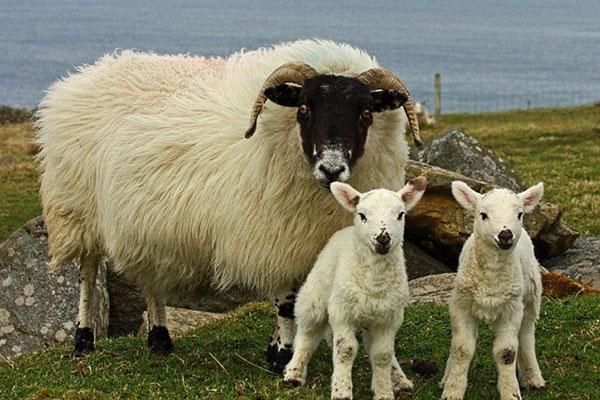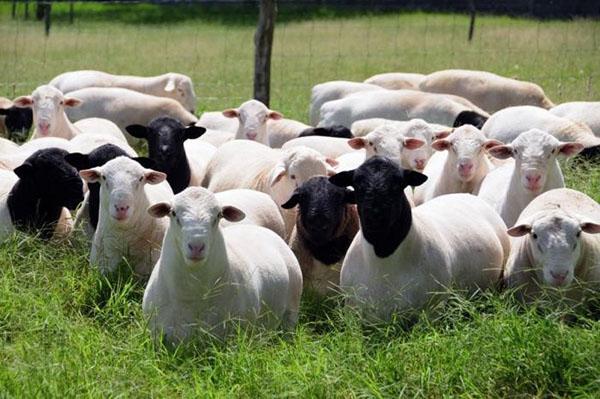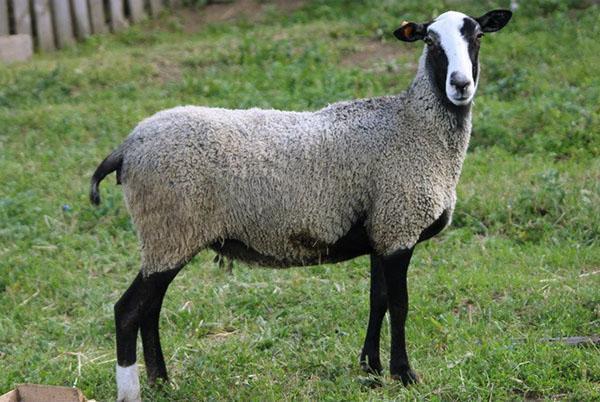Sheep breeds for home keeping
 Domestic sheep are one of the fastest growing, non-capricious and productive animals in the backyard. It is not surprising that the first breeds of sheep for domestic breeding appeared many thousands of years ago. The selection process does not stop today. If earlier universal animals were the most valuable, giving their owner wool and meat, skins, milk and valuable fat, now more and more preference is given to a variety with a clear focus.
Domestic sheep are one of the fastest growing, non-capricious and productive animals in the backyard. It is not surprising that the first breeds of sheep for domestic breeding appeared many thousands of years ago. The selection process does not stop today. If earlier universal animals were the most valuable, giving their owner wool and meat, skins, milk and valuable fat, now more and more preference is given to a variety with a clear focus.
Depending on the climate, needs and demand, large and small farms specialize in growing:
- meat breeds of sheep;
- meat-feeding and meat-wool varieties;
- animals that provide high quality skins and wool.

Features of sheep breeds, their photos and descriptions will help novice sheep breeders get acquainted with these animals and competently form their own flock.
Romanov breed of sheep
 A primordially Russian breed of sheep that appeared on the farms of the Yaroslavl province back in the 18th century. Despite the venerable age for the species of domestic animals, the breed is still extremely popular and widespread.
A primordially Russian breed of sheep that appeared on the farms of the Yaroslavl province back in the 18th century. Despite the venerable age for the species of domestic animals, the breed is still extremely popular and widespread.
A characteristic feature of the Romanov breed of sheep is high fertility.
Due to the ability of the queens to bring several lambs at once and kitten, regardless of the season, the animals show excellent meat productivity, although the weight of rams and adult females is far from the representatives of true meat breeds of sheep.
 Lambs of the Romanov breed of sheep are rapidly gaining weight. A seven-month-old young growth weighs about 30–35 kg. The weight of the rams that have reached maturity reaches 80–100 kg, while the female is half as light. Today, this breed for home keeping is of high interest from the owners of private farms and farmsteads. In addition to good quality meat, healthy milk with a fat content of about 7% is obtained from animals.
Lambs of the Romanov breed of sheep are rapidly gaining weight. A seven-month-old young growth weighs about 30–35 kg. The weight of the rams that have reached maturity reaches 80–100 kg, while the female is half as light. Today, this breed for home keeping is of high interest from the owners of private farms and farmsteads. In addition to good quality meat, healthy milk with a fat content of about 7% is obtained from animals.
During the lactation period, a sheep is capable of producing up to one hundred liters of a valuable product.
Eldibaevskaya breed of sheep
 The ancestors of the sheep of the Edilbaev breed obtained in the century before last are fat-tailed Kazakh animals and large coarse-wooled sheep from the Astrakhan province. The descendants of these hardy species inherited the best features of their parents and were able to survive even in the harshest steppe conditions, in arid climates, on a small amount of scarce food.
The ancestors of the sheep of the Edilbaev breed obtained in the century before last are fat-tailed Kazakh animals and large coarse-wooled sheep from the Astrakhan province. The descendants of these hardy species inherited the best features of their parents and were able to survive even in the harshest steppe conditions, in arid climates, on a small amount of scarce food.
Edilbaevskie sheep are a breed that can withstand heat, cold, piercing wind.
In search of new pastures, animals cover considerable distances and at the same time manage to grow up to 120 kg of weight in rams, and 75 kg in sheep. Today, this breed of sheep can be seen not only in the Kazakh steppes, but also in the southern regions of Russia, where the endurance and high meat productivity of animals is also appreciated.
Hissar breed of sheep
 Lamb fat is valuable, especially in areas of traditional sheep breeding, a product that has determined the appearance of a whole variety of animal breeds. Meat-tailed or fat-tailed sheep are still the most recognized in Asia, the Middle East, and the Caucasus. Fat in the body of fat-tailed sheep breeds does not accumulate evenly, but only in the tail area, forming many kilogram reserves.
Lamb fat is valuable, especially in areas of traditional sheep breeding, a product that has determined the appearance of a whole variety of animal breeds. Meat-tailed or fat-tailed sheep are still the most recognized in Asia, the Middle East, and the Caucasus. Fat in the body of fat-tailed sheep breeds does not accumulate evenly, but only in the tail area, forming many kilogram reserves.
The Gissar breed of sheep is a striking representative of the meat-sucking variety. Large animals grow up to 190 in weight, and they account for almost a third of their body weight per sheep fat tail.
 Hardy sheep, perfectly adapted to mountain grazing and crossings, enjoyed wide popularity during the Soviet era, and are still actively raised in private farmsteads. These animals have good immunity, and grow rapidly, but do not differ in fertility. The weight of an adult sheep reaches 90, and sometimes 150 kg, the rams are even larger. The mass of meat carcasses exceeds 140, and the fat tail sheep - 180 kg. Sheep give up to 120 liters of milk in a couple of months of lactation.
Hardy sheep, perfectly adapted to mountain grazing and crossings, enjoyed wide popularity during the Soviet era, and are still actively raised in private farmsteads. These animals have good immunity, and grow rapidly, but do not differ in fertility. The weight of an adult sheep reaches 90, and sometimes 150 kg, the rams are even larger. The mass of meat carcasses exceeds 140, and the fat tail sheep - 180 kg. Sheep give up to 120 liters of milk in a couple of months of lactation.
Sheep breed Merino
 Merino is considered to be a kind of standard for wool sheep breeds. This breed of sheep was first obtained in the Iberian Peninsula. And the Spaniards are still rightfully proud of this fact, considering the Merino sheep a national treasure. Now Australia is recognized as the world center for breeding these animals. Fine-wooled sheep have thick, soft wool, which, after shearing and processing, is used to make clothes, knitwear and fabrics of the highest quality.
Merino is considered to be a kind of standard for wool sheep breeds. This breed of sheep was first obtained in the Iberian Peninsula. And the Spaniards are still rightfully proud of this fact, considering the Merino sheep a national treasure. Now Australia is recognized as the world center for breeding these animals. Fine-wooled sheep have thick, soft wool, which, after shearing and processing, is used to make clothes, knitwear and fabrics of the highest quality.
 In comparison with sheep of meat breeds, Merino sheep cannot be called large, but the amount of white fine wool from one individual can reach 18 kg. Today, sheep breeders have at their disposal several dozen breeds and pedigree lines derived from Merino or equal to them in quality and quantity of fine wool.
In comparison with sheep of meat breeds, Merino sheep cannot be called large, but the amount of white fine wool from one individual can reach 18 kg. Today, sheep breeders have at their disposal several dozen breeds and pedigree lines derived from Merino or equal to them in quality and quantity of fine wool.
 In the first half of the 20th century, the USSR obtained its own variety of Merino sheep. The ancestors of the Soviet merino, which was not inferior to the famous Spaniards and Australians, were domestic sheep from Altai, Stavropol and Chechnya, as well as representatives of the Rambouillet sheep breed. Unlike foreign Merino, domestic animals are larger. Sheep weigh about 110 kg, and sheep are about half as light. This interesting breed of sheep is still interesting to Russian sheep breeders and is used in breeding work.
In the first half of the 20th century, the USSR obtained its own variety of Merino sheep. The ancestors of the Soviet merino, which was not inferior to the famous Spaniards and Australians, were domestic sheep from Altai, Stavropol and Chechnya, as well as representatives of the Rambouillet sheep breed. Unlike foreign Merino, domestic animals are larger. Sheep weigh about 110 kg, and sheep are about half as light. This interesting breed of sheep is still interesting to Russian sheep breeders and is used in breeding work.
 The French branch of the Merino is represented by the Precos sheep breed with excellent fine wool and equally high meat production. The history of the breed dates back to the 19th century. In the last century, a precocious variety was bred. The animals showed themselves to be hardy, easily adapting even to the harsh northern conditions. At the same time, the Prekos, in comparison with only woolly oriented breeds, require extensive pastures.
The French branch of the Merino is represented by the Precos sheep breed with excellent fine wool and equally high meat production. The history of the breed dates back to the 19th century. In the last century, a precocious variety was bred. The animals showed themselves to be hardy, easily adapting even to the harsh northern conditions. At the same time, the Prekos, in comparison with only woolly oriented breeds, require extensive pastures.
Adult rams grow up to 120 kg in weight, the mass of sheep often reaches 70 kg. Sheep of the Prekos breed are more fertile than other animals of the merino, they are good mothers, which is fully justified due to the risk of the appearance of a weakened offspring in need of care.
Kuibyshev breed of sheep
 Another domestic breed of sheep for home keeping has a meat orientation, excellent early maturity and endurance. At the same time, the Kuibyshev breed of sheep demonstrates excellent consumer characteristics of a dense, without the characteristic of mutton smell of dietary meat.
Another domestic breed of sheep for home keeping has a meat orientation, excellent early maturity and endurance. At the same time, the Kuibyshev breed of sheep demonstrates excellent consumer characteristics of a dense, without the characteristic of mutton smell of dietary meat.
 Kuibyshev sheep are easily recognizable by their strong constitution, muscular legs, broad back and chest, tight short neck and hornless head. Most of all, these beef sheep are reminiscent of the famous Romney March animals.
Kuibyshev sheep are easily recognizable by their strong constitution, muscular legs, broad back and chest, tight short neck and hornless head. Most of all, these beef sheep are reminiscent of the famous Romney March animals.
The ram weighs 190 kg, females weigh about 100 kg. Lambs of the Kuibyshev breed are early maturing and catch up with their mothers in weight already when they reach six months.
Dorper sheep breed
 The South African Dorper sheep were obtained by local breeders for the purpose of breeding, in the rather harsh conditions of the continent, a livestock of productive meat-and-wool sheep with high endurance and excellent early maturity. As a basis for the work were taken animals Dorset Horn and Black-headed Persian sheep of fat tail and other species.
The South African Dorper sheep were obtained by local breeders for the purpose of breeding, in the rather harsh conditions of the continent, a livestock of productive meat-and-wool sheep with high endurance and excellent early maturity. As a basis for the work were taken animals Dorset Horn and Black-headed Persian sheep of fat tail and other species.
 Dorper did not disappoint the expectations of scientists and sheep breeders.For about a century, this breed of sheep has confirmed its ability to survive almost in the desert, do without juicy feed and perfectly gain weight on long journeys on rocky slopes.
Dorper did not disappoint the expectations of scientists and sheep breeders.For about a century, this breed of sheep has confirmed its ability to survive almost in the desert, do without juicy feed and perfectly gain weight on long journeys on rocky slopes.
The weight of a ram reaches 140 kg, adult females are half as small. The same weight, about 50–60 kg, is reached by half-year-old lambs.
Texel sheep breed
 The Texel sheep breed is considered one of the oldest in Europe. There is even an opinion that animals with similar characteristics of the meat-and-wool direction were known back in the days of Great Rome. But they began to pay special attention to early maturing hornless sheep in the century before last. It was at this time that individuals of Dutch origin received an infusion of new British bloods, and a new standard was formed for worthy cultivation in private farms and in large farms of the breed.
The Texel sheep breed is considered one of the oldest in Europe. There is even an opinion that animals with similar characteristics of the meat-and-wool direction were known back in the days of Great Rome. But they began to pay special attention to early maturing hornless sheep in the century before last. It was at this time that individuals of Dutch origin received an infusion of new British bloods, and a new standard was formed for worthy cultivation in private farms and in large farms of the breed.
 As a result of breeding work, sheep breeders and scientists managed to obtain an ideal combination of meat productivity and the presence of soft, high-quality wool in large animals.
As a result of breeding work, sheep breeders and scientists managed to obtain an ideal combination of meat productivity and the presence of soft, high-quality wool in large animals.
Sheep grow up to 70 kg, the weight of adult rams can exceed 160 kg.
Animals are early maturing, unpretentious and have good immunity, which is important when keeping a breed of sheep at home. Therefore, today the Texel sheep breed is chosen by thousands of owners of farmsteads all over the world and in Russia, in particular.